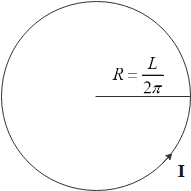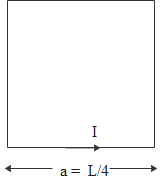
Two identical wires A and B, each of length L, carry the same current I. Wire A is bent into a circle of radius R and wire B is bent to form a square of side ‘a’. If ${{B}_{A}}$ and ${{B}_{B}}$ are the values of magnetic field at the centre of the circle and square respectively, then what is the value of the ratio $\dfrac{{{B}_{A}}}{{{B}_{B}}}$?
A. $\dfrac{{{\pi }^{2}}}{8\sqrt{2}}$
B. $\dfrac{{{\pi }^{2}}}{8}$
C. $\dfrac{{{\pi }^{2}}}{16\sqrt{2}}$
D. $\dfrac{{{\pi }^{2}}}{16}$
Answer
565.5k+ views
Hint: Use expressions of magnetic field at the centre of the circular loop and magnetic field at the centre of the square to obtain ${{B}_{A}}$ and ${{B}_{B}}$. Then take their ratio to obtain the result. Alternatively, We can also use Biot-Savart Law to find magnetic fields at centres of the circle and square. Biot-Savart law describes the magnetic field at a point due to a small current carrying segment. This segment is considered as vector quantity and its direction is along the direction of current.
Formula used:
Magnetic field in case of circle of radius R, $B=\dfrac{{{\mu }_{0}}I}{2R}$; Magnetic field in case of square of side a, $B=\dfrac{4{{\mu }_{0}}I}{\pi a\sqrt{2}}$
Complete answer:
Both wires carry current I and are of length L.
Magnetic field for a circle of radius R is given by
$B=\dfrac{{{\mu }_{0}}I}{2R}$
Length of wire A is L and when the wire is bent into a circular loop its perimeter is equal to length of wire.
$2\pi R=L\Rightarrow R=\dfrac{L}{2\pi }$

Therefore, magnetic field due to a circle formed by wire A
${{B}_{A}}=\dfrac{{{\mu }_{0}}I}{2R}=\dfrac{{{\mu }_{0}}I}{2\dfrac{L}{2\pi }}=\dfrac{\pi {{\mu }_{0}}I}{L}$
Length of wire B is L and when the wire is bent into a square loop its perimeter is equal to length of wire.
$4a=L\Rightarrow a=\dfrac{L}{4}$

Therefore, magnetic field due to a square formed by wire B
${{B}_{B}}=\dfrac{4{{\mu }_{0}}I}{\pi a\sqrt{2}}=\dfrac{4{{\mu }_{0}}I}{\pi \dfrac{L}{4}\sqrt{2}}=\dfrac{16{{\mu }_{0}}I}{\pi L\sqrt{2}}$
Taking ratios of ${{B}_{A}}$ and ${{B}_{B}}$, we get
$\dfrac{{{B}_{A}}}{{{B}_{B}}}=\dfrac{\dfrac{\pi {{\mu }_{0}}I}{L}}{\dfrac{16{{\mu }_{0}}I}{\pi L\sqrt{2}}}=\dfrac{\pi {{\mu }_{0}}I}{L}\times \dfrac{\pi L\sqrt{2}}{16{{\mu }_{0}}I}$
On simplifying
$\dfrac{{{B}_{A}}}{{{B}_{B}}}=\dfrac{{{\pi }^{2}}}{8\sqrt{2}}$
So, the correct answer is “Option A”.
Note:
When two identical wires with same current flowing through them are bent to form square loop and circular loop respectively. The magnetic field due to the circular loop is approximately 0.87 times the magnitude of the magnetic field at the centre of the square.
Formula used:
Magnetic field in case of circle of radius R, $B=\dfrac{{{\mu }_{0}}I}{2R}$; Magnetic field in case of square of side a, $B=\dfrac{4{{\mu }_{0}}I}{\pi a\sqrt{2}}$
Complete answer:
Both wires carry current I and are of length L.
Magnetic field for a circle of radius R is given by
$B=\dfrac{{{\mu }_{0}}I}{2R}$
Length of wire A is L and when the wire is bent into a circular loop its perimeter is equal to length of wire.
$2\pi R=L\Rightarrow R=\dfrac{L}{2\pi }$

Therefore, magnetic field due to a circle formed by wire A
${{B}_{A}}=\dfrac{{{\mu }_{0}}I}{2R}=\dfrac{{{\mu }_{0}}I}{2\dfrac{L}{2\pi }}=\dfrac{\pi {{\mu }_{0}}I}{L}$
Length of wire B is L and when the wire is bent into a square loop its perimeter is equal to length of wire.
$4a=L\Rightarrow a=\dfrac{L}{4}$

Therefore, magnetic field due to a square formed by wire B
${{B}_{B}}=\dfrac{4{{\mu }_{0}}I}{\pi a\sqrt{2}}=\dfrac{4{{\mu }_{0}}I}{\pi \dfrac{L}{4}\sqrt{2}}=\dfrac{16{{\mu }_{0}}I}{\pi L\sqrt{2}}$
Taking ratios of ${{B}_{A}}$ and ${{B}_{B}}$, we get
$\dfrac{{{B}_{A}}}{{{B}_{B}}}=\dfrac{\dfrac{\pi {{\mu }_{0}}I}{L}}{\dfrac{16{{\mu }_{0}}I}{\pi L\sqrt{2}}}=\dfrac{\pi {{\mu }_{0}}I}{L}\times \dfrac{\pi L\sqrt{2}}{16{{\mu }_{0}}I}$
On simplifying
$\dfrac{{{B}_{A}}}{{{B}_{B}}}=\dfrac{{{\pi }^{2}}}{8\sqrt{2}}$
So, the correct answer is “Option A”.
Note:
When two identical wires with same current flowing through them are bent to form square loop and circular loop respectively. The magnetic field due to the circular loop is approximately 0.87 times the magnitude of the magnetic field at the centre of the square.
Recently Updated Pages
Master Class 12 Business Studies: Engaging Questions & Answers for Success

Master Class 12 Social Science: Engaging Questions & Answers for Success

Master Class 12 English: Engaging Questions & Answers for Success

Master Class 12 Chemistry: Engaging Questions & Answers for Success

Class 12 Question and Answer - Your Ultimate Solutions Guide

Master Class 12 Economics: Engaging Questions & Answers for Success

Trending doubts
How much time does it take to bleed after eating p class 12 biology CBSE

When was the first election held in India a 194748 class 12 sst CBSE

December 10th of 1948 is an important day in the history class 12 sst CBSE

The computer jargonwwww stands for Aworld wide web class 12 physics CBSE

The first microscope was invented by A Leeuwenhoek class 12 biology CBSE

Give simple chemical tests to distinguish between the class 12 chemistry CBSE




